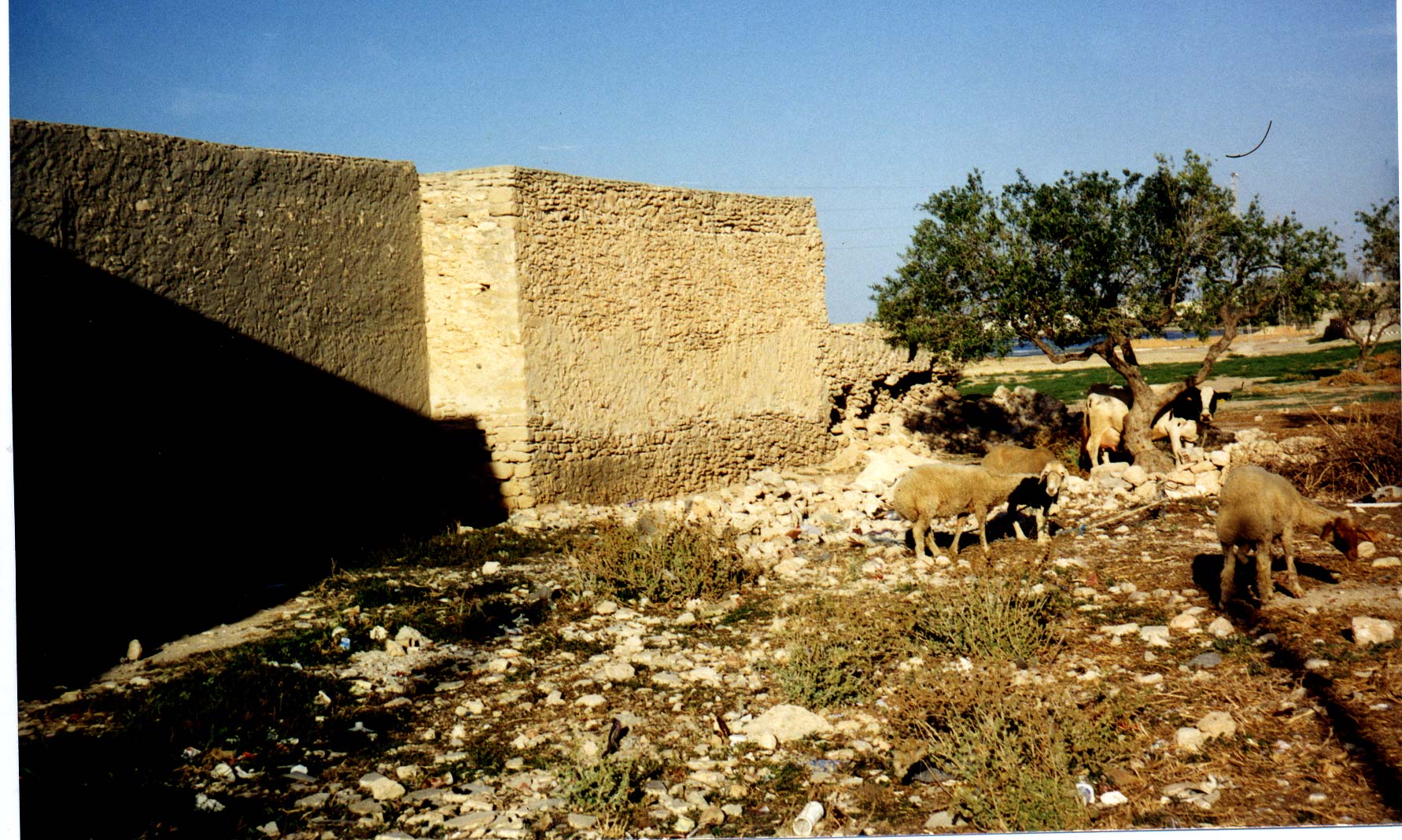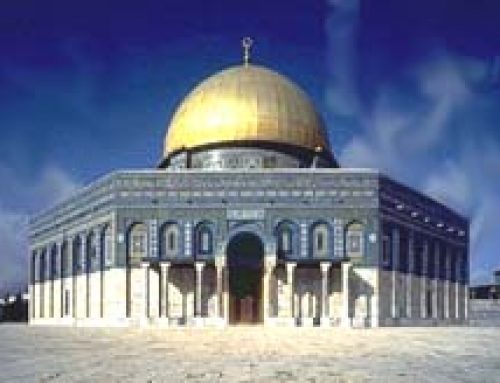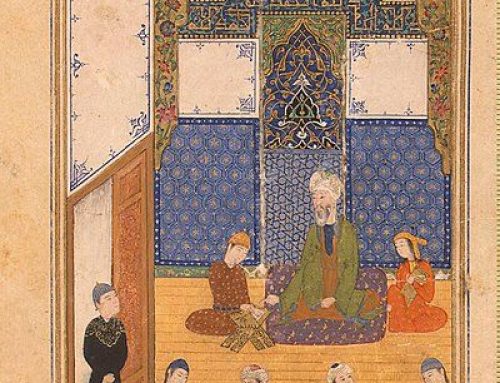
Tomb of Ali, the first Imam and the fourth caliph, in Iraq (it was rebuilt about 1500 AD by the Safavids)
Mohammed died in 632 AD. His second wife’s father, a rich man named Abu Bakr, took over as caliph. He became the leader of the new religion of Islam, and of the newly united Arab tribes. Mohammed left no sons, and in any case there was no tradition of sons taking over in the Arab world.
When they heard that Mohammed had died, the Arab tribes wanted to go back to being independent from Abu Bakr. We call that revolt the Ridda. But Abu Bakr got together an army. He destroyed the Ridda and brought those Arab tribes back under Islamic control. Abu Bakr was already pretty old. He only lived for two years after becoming caliph. But he managed to unite the whole Arabian Peninsula under Islam.
Almost as soon as he got power, in 634 AD, the second caliph Omar led Arab raids into both the Roman and the Sassanid empires. Both raids were very successful. The Arabs had been doing most of the fighting for the Romans and the Sassanians. They knew that neither the Romans nor the Sassanians had good armies anymore. Omar was assassinated in 644 AD, and succeeded by Uthman. Encouraged by these early victories, Uthman and his army organized a real campaign. By 651 AD they took over most of West Asia, from the Mediterranean coast to eastern Iran.
Uthman was also assassinated, in 656, and the fourth caliph was Ali. Ali had a more radical view of the Islamic faith. He wanted everyone to be equal, and cooperate together. Under Ali, the soldiers of the Islamic Empire fought their way through Egypt and North Africa. Even though Ali was assassinated in 661, the armies kept on going. They crossed the Straits of Gibraltar to attack Visigothic Spain in 710 AD.

A Ribat, or fort, in North Africa
The Umayyads founded Kairouan, the fourth holy city of Islam, in Tunisia, in the late 600s AD.
As the Arabs made their way through North Africa, they built small forts or ribats all over the place. They guard against attack, especially along the coast. Many ribats are still there today. This is a ribat from a village in Tunisia called Lamta (notice the goats grazing near it).

Great Mosque in Damascus
After the death of Ali, there was a bitter religious and political struggle between different groups of Muslims. The Sunnis were followers of a more traditional Islamic faith. The Shiites (SHE-eye-ts) were the radical followers of Ali. The Sunnis won. They established the Umayyad dynasty, with its capital at Damascus in Syria. But there were still lots of Shiites, and they were pretty angry about it.

Dome of the Rock mosque, Jerusalem
In Jerusalem, the Umayyads built the first major mosque. That was the Dome of the Rock. It was on the site of Solomon’s Temple (and the place where Abraham almost sacrificed Isaac). They began building it in 687 AD and finished it in 691 AD.
Eventually the Umayyad armies met people they couldn’t beat. In the West, the Romans stopped Islamic attacks against Constantinople in 674-678 and again in 717 AD. The Frank Charles Martel, grandfather of Charlemagne, turned back a series of Islamic raids into France in 732 AD. But the Umayyad dynasty didn’t last much longer. In 750 AD, the Abbasid family killed off all the remaining Umayyads but one, and took over as the Abbasid Caliphs. The one surviving Umayyad man fled to safety in Spain, where he established the Umayyad dynasty of Spain.
Learn by doing: playing chess
More about Umayyad Spain
More about the Abbasids
Bibliography and further reading about the Umayyads:





Hi,
just a casual read of this article shows some incorrect information:
1- Kairouan is not a holy city in Islam, its an old trade and government center in north Africa with great history and culture.
2- The first mosque built was in Madinah and its called Quba’a mosque and the first major Mosque was Al-Masjed Al-Nabawi in Madinah also.
3- Ali was not “more radical” (what does that even mean?? did he skateboard?) he was following the path of his predecessors with different political challenges. After his death the Shi’aa claimed his Son’s right to rule and fought for it.
4 – King Solomon’s Temple “may” have been at the site of the Mosque in Jerusalem, no proof has been found yet. (The zionists are using this claim to plan on destroying Al-Aqsa Mosque)
5- The Romans were eventually beat in Constantinople and the Ottoman’s reached the walls of Vienna.
Your representation of Islam is biased towards war conquest and assassinations which is not historically accurate. There is no reference to the Golden age of Islam, the science, technology, medicine or great civilization that was built and still exists in different parts of the world.
Thanks,
Hi Ahmed,
Thanks for writing!
1) Kairouan is the fourth holy city of Islam (https://medium.com/@Rashmee/kairouan-in-tunisia-is-very-conscious-that-it-is-the-fourth-holiest-city-of-islam-ab8f168e07ab), but it was certainly also an important trade center (not so much a government center, as the capital was in Mahdia and then in Tunis.)
2) Al-Masjed Al-Nabawi was earlier than the Dome of the Rock, and later was rebuilt as an important structure, but at the time that the Dome of the Rock was built, Al-Masjed Al-Nabawi was still only a small building.
3) You may be interested in our page on Shia Islam here: https://quatr.us/history/whats-difference-shiite-sunni.htm – by radical, I mean that they drew their support more from ordinary people and less from rich people.
4) Israel’s government is not planning to destroy Al-Aqsa Mosque, but there is evidence that Solomon’s temple stood there. Certainly the Second temple stood there; its remains are still there now. This article gives a pretty fair assessment: https://www.smithsonianmag.com/history/what-is-beneath-the-temple-mount-920764/
5) You may be interested in reading our article about the Ottoman Empire and Vienna: https://quatr.us/history/ottoman-empire-pashas-1656-1700-ad.htm